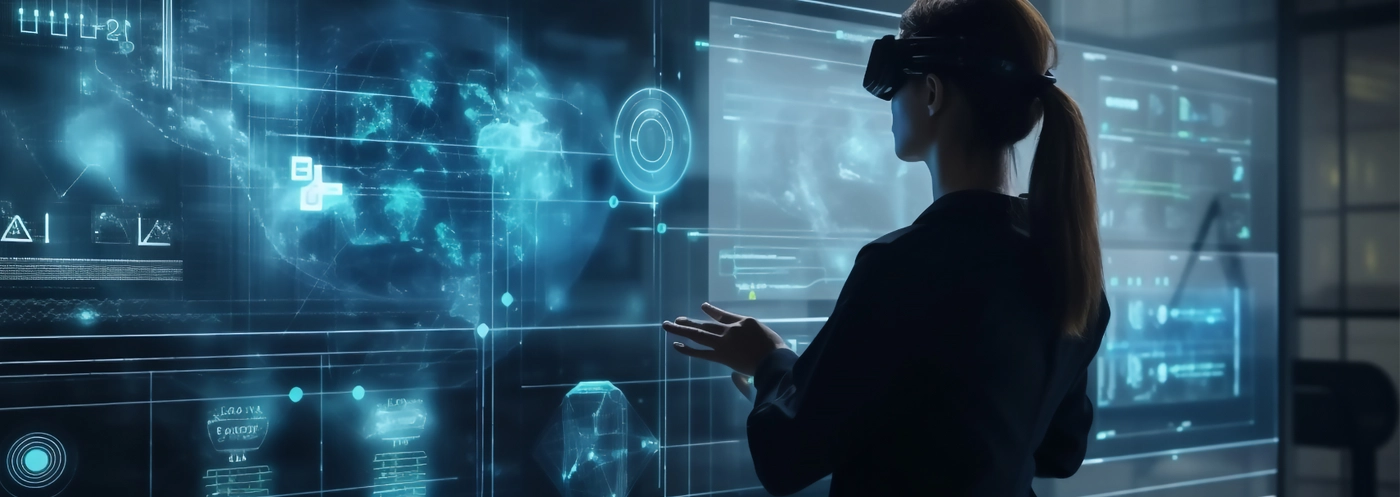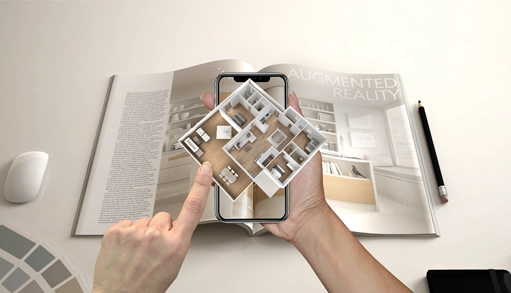
AR and VR in UX: Challenges in the Transformation
 Krishnan Ramachandran
Krishnan RamachandranLead, UX

Augmented Reality and Virtual Reality are enhancing and transforming the ways users interact with digital products and environments. While the promise of AR and VR is enormous, these disruptive technologies are not without obstacles and ethical concerns. Recognizing and resolving these problems are crucial in ensuring the appropriate and effective adoption of AR and VR in user experiences.
Augmented Reality (AR) and Virtual Reality (VR) have been significantly impacting User Experience (UX) design in a variety of ways. These immersive technologies are enhancing and transforming the ways users interact with digital products and environments. In the first part of this blog, we discussed how AR and VR are transforming UX and their applications in several fields. In this blog, we examine the various concerns and challenges that these technologies bring in, the best practices to deal with them, and explain in detail how Reflections is integrating this technology to serve our diverse clientele.
Challenges and Considerations
While the promise of AR and VR is enormous, these disruptive technologies are not without obstacles and ethical concerns. Recognizing and resolving these problems are crucial in ensuring the appropriate and effective adoption of AR and VR in user experiences.
Specialized Hardware Requirements
- Device Compatibility:
Applications using AR frequently require specialized hardware components, such as cameras, sensors, and CPUs, to perform efficiently. Not all smartphones have the requisite capability to run AR applications properly. Users with older or less sophisticated devices may not enjoy a comfortable AR experience.
- Smartphone Performance:
Many AR experiences are optimized for mobile devices. The performance of the smartphone or tablet, including processor power and camera quality, has a direct influence on the quality of the AR experience. Lower-end devices may struggle to run AR apps smoothly.
- AR Glasses:
For more complex AR experiences, specialist AR glasses or headsets are necessary. While these gadgets provide a more immersive AR experience, they can be costly, and their adoption is still restricted. Furthermore, the style and comfort of AR glasses might influence the user’s experience.
- Battery Life:
AR applications are known to use more power. Running AR apps, particularly those that use the camera continually, can quickly deplete a device’s battery. This constraint might be aggravating for users, especially when a power source is not immediately available.
- Data Connectivity:
Augmented Reality relies on real-time data, which necessitates a steady internet connection. Delayed or sporadic connectivity might interrupt the AR experience, resulting in delayed loading times or data-related issues.
- Accuracy of Sensors:
For tracking and location, AR relies on the precision of sensors such as gyroscopes, accelerometers, and GPS. If these sensors fail or are inaccurate, it might cause inconsistencies and jitters in the AR overlay, impacting the entire experience.
Platform Fragmentation:
There are several AR systems and devices available, including ARKit for iOS and ARCore for Android. Developers may need to optimize their AR apps for multiple platforms and hardware, which may be time consuming and difficult.
Motion Sickness:
Virtual Reality poses a difficulty in the form of motion sickness. This discomfort is caused by a mismatch in perception between what users see in the virtual environment and what their inner ear perceives. Design considerations are crucial in reducing this problem. To reduce the possibility of motion sickness, designers must incorporate tactics such as maintaining high frame rates, decreasing latency, and avoiding quick, excessive motions in the virtual environment.
Privacy Concerns
Data Capture: AR can record real-time data about the user’s surroundings, especially when combined with wearable devices such as smart glasses. Images, video, music, and location data can all be included. While this data is frequently utilized to improve the AR experience (e.g., by presenting contextual information), it also poses privacy concerns. Users may be unaware of when and what data is being collected, possibly jeopardizing their privacy.
- Surveillance and Recording: AR gadgets with recording capability may be considered an invasion of privacy. Users can record conversations or capture images without the knowledge or approval of anyone around them. This can result in privacy violations in public spaces, workplaces, or private meetings.
- Data Security: AR data storage and transmission could offer privacy concerns. If sensitive data is not adequately protected, it might be vulnerable to unauthorized access and misuse, potentially leading to identity theft or other privacy violations.
- Geolocation Data: This data is frequently used in AR to deliver contextually relevant information. Sharing exact location information, on the other hand, may subject users to monitoring or unwanted intrusion.
Ethical Dilemmas in Virtual Reality
- Addiction and Overuse: The immersive quality of VR might raise worries about addiction and misuse. Users might become absorbed in VR experiences at the expense of other elements of their lives, including jobs, relationships, and physical health. Designers and developers must consider appropriate usage and promote balanced screen time.
- Content Ethics: VR content may range from educational and therapeutic uses to entertainment and games. When VR entertainment contains violence, explicit or damaging themes, or prejudice, ethical issues arise. Designers and developers must take responsibility for selecting and developing information that is consistent with social ideals and ethical norms.
- Informed Consent: Users participating in VR experiences may not always be entirely aware of the nature of the content they are going to encounter. Ethical quandaries might arise when consumers are exposed to information that they find unsettling or emotionally painful without enough notice or informed permission.
- Privacy and Data Protection: VR experiences frequently capture data about user behaviors, preferences, and interactions inside the virtual environment. The ethical use and safeguarding of this data, especially how it is shared with third parties, is critical. Users should be informed about data gathering practices and given the choice to control their data.
Upholding Best Practices for AR and VR UX
Intuitive Navigation
- In both AR and VR worlds, easy navigation is critical. Users should be able to engage with virtual material simply and organically, making their experience smooth and user friendly.
- This implies that menus, controls, and interactions inside the virtual environment should be made to be as near to real-world interactions as feasible, so users can immediately comprehend how to navigate and utilize the interface.
Motion Sickness Mitigation
- Virtual reality experiences can occasionally cause motion sickness, which is a critical issue to overcome. It is critical to maintain high frame rates (usually 90 Hz or greater) to provide a smooth and comfortable experience.
- Minimizing latency (the delay between a user’s action and the system’s response) is equally important to avoid motion sickness.
- Designers should also avoid developing experiences with sudden or severe virtual motions that might cause discomfort. Transitions must be gradual and smooth to reduce motion sickness.
Inclusive Design
- Inclusive design concepts strive to make AR and VR experiences as accessible and useable as feasible for individuals of all skills and limitations. This is not only ethical, but it may also expose your experiences to a larger audience.
- Consider elements such as font size, color contrast, audio explanations for visual material, and navigational options (e.g., voice commands for individuals with restricted mobility). Accessibility guidelines and standards, such as Web Content Accessibility Guidelines (WCAG), can give useful information.
Rigorous User Testing
- User testing is an essential step in the design process. It involves soliciting feedback from real users to understand how they interact with your AR and VR interfaces and how their experiences can be improved.
- User testing should be an ongoing process, conducted at various stages of design and development. It helps identify issues, pain points, and opportunities for enhancement.
- Continuous user feedback enables iterative design improvements, resulting in more user-friendly and effective AR and VR interfaces.
Exploring the AR and VR Frontier: Reflections’ Journey Towards Immersive UX and Innovation
At Reflections, we successfully drive the transformation of our customers’ business and we have seamlessly aligned with the transformational impact of AR and VR on UX and their applications in various domains. Here is a synopsis of how Reflections aligns with the key themes and considerations discussed in relation to AR and VR in UX:
- Immersive Engagement: Reflections leverages AR and VR to create immersive and engaging experiences for its customers or clients. Whether it is through virtual showrooms, interactive product demonstrations, or immersive marketing campaigns, we understand the importance of immersive engagement.
- Real-World Integration: We integrate AR to provide contextual information for our customers. This could include using AR overlays for product information or incorporating AR technology into marketing materials to enhance the real-world experience.
- Spatial Interaction: We recognize the importance of spatial interaction in enhancing user engagement. By using AR and VR, Reflections provides interactive product displays or simulations, allowing customers to interact with products virtually.
- Personalization: As experts in the field, we likely understand the potential for personalization in AR and VR. We use these technologies to tailor experiences, products, or services to individual preferences, creating a more engaging and satisfying UX.
- Applications in Different Industries: Reflections has a diversified presence across multiple industries, including retail, healthcare, logistics, finance, manufacturing, gaming, education, and design. We actively investigate the application of AR and VR technologies within these sectors to devise pioneering and transformative solutions.
- Upholding Best Practices: We adhere to the best practices for AR and VR UX, including intuitive navigation, motion sickness mitigation, inclusive design, and rigorous user testing. This commitment to providing user-friendly experiences is setting our company apart.
- Continuous Innovation: To stay at the forefront of AR and VR technologies, we keep up with the latest advancements in the field. This ensures that our company remains competitive and will continue to redefine the possibilities in the digital arena.
Conclusion
In conclusion, it is evident that Reflections is well-positioned to harness the transformative capabilities of AR and VR in elevating user experiences across diverse industries. By actively adopting these technologies and proactively tackling their challenges through best practices and a commitment to ongoing innovation, we stand ready to provide state-of-the-art, user-centric solutions that cater to the ever-changing technology landscape and evolving user demands.
Author:
Krishnan Ramachandran, Lead, UX